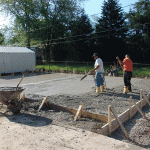What is 5 bag mix, 6 bag mix, 3000 PSI, 3500 PSI, 4000 PSI, etc…
As a Chicago Concrete Contractor serving Chicago, IL and all surrounding suburbs, I always find myself helping our clients become more educated on the concrete they will be receiving. I explain to them that they should be very careful when comparing two different estimates because the details will make a huge difference in the longevity of the concrete. All concrete is not created equally!!! Like our modern food ingredients, concrete has gained many additives that offset the expensive ingredients. One of those expensive ingredients in concrete is Portland cement.
In the earlier days of ordering concrete, the concrete contractor would simply ask the ready-mix supplier for a mix based on the number of bags of Portland cement added, i.e. 5 bag, 6 bag, ect. which would dictate the compressive strength of concrete. Today with all the additives and mix designs for different applications, the deciding factors after all the ingredients are added is still the compressive strength measured today in PSI (Pounds per square inch) that the concrete can withstand before failing. So does that mean the stronger the better? Not necessarily, there is a point of diminishing return when the average homeowner or concrete contractor gets too smart for their own good. High amounts of Portland help contribute to shrinkage cracks along with too much water. These are just the beginning of many problems that most contractors do not consider when placing an order for their clients concrete.
6 bag, ect. which would dictate the compressive strength of concrete. Today with all the additives and mix designs for different applications, the deciding factors after all the ingredients are added is still the compressive strength measured today in PSI (Pounds per square inch) that the concrete can withstand before failing. So does that mean the stronger the better? Not necessarily, there is a point of diminishing return when the average homeowner or concrete contractor gets too smart for their own good. High amounts of Portland help contribute to shrinkage cracks along with too much water. These are just the beginning of many problems that most contractors do not consider when placing an order for their clients concrete.
So what is a good mix to use? It all depends on the application. Foundation footings and walls are usually poured using a 3,000 PSI mix and is usually more than sufficient for most foundation purposes. For interior flatwork which is not exposed to freeze thaw cycles, a 3,000 PSI mix without air entrainment should work fine in most cases. Where things start getting a little tricky are in the outdoor arena where freezing and thawing cycles will take its toll. We recommend a 6-1/2 bag mix or 4,000 PSI concrete with a 6-8% air entrainment and low slump in the 3-4“range to avoid Spalling of the surface from the winter. Then depending on the weather conditions, one might add fiber-mesh and a retarder to help the workability of the concrete and avoid shrinkage cracks. Also depending on the application, there are many other additives that the run of the mill concrete contractor is unaware that exist to make the job easier and provide a lasting product for the homeowner. Buyers beware; check that your contractor has a “Concrete Masons” License and not a “Home Repair” license.
Hello, I enjoyed your website. This is a cool site and I wanted to post a little note to let you know, nice job! Thanks Tammy
What size of cement bags are used in a 6 bag mix? 40lb or the larger 80lb? Can’t seem to find this anywhere.
Love your site man keep up the good work
A 94 lb bag of portland in a “Straight Bag Mix” (no fly ash) yields about 6 cubic feet. So 4.5 bags of portland would be needed to produce a single yard of conrete along with an additional 2 parts sand, and 3 parts gravel.